Batts, Blown, or Sprayed – What’s the Best Attic Insulation?
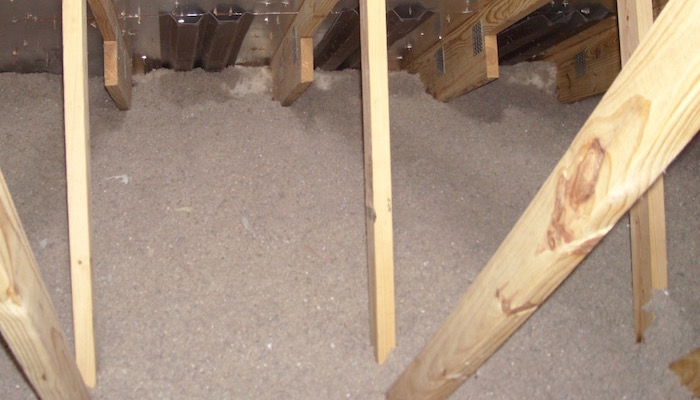
I get asked a lot of questions about windows, air conditioning, and other energy efficiency topics: What size HVAC system should I install? Is it true you can seal a house up too tight? Can I use a CFL bulb in my Easy-Bake Oven? I also get asked about insulation, and that’s today’s topic. I’m going to stick to the attic here, but much of what I say could apply to walls or floors, too.
The first thing to know is that you really have only three choices here. Well, OK, you have more than three, but I’m mostly going to talk about those three because in terms of what you’ll be able to find someone to install, these are the ones you’re mostly limited to.
Before you ever get insulation anywhere near the attic, though, make sure that you get the air leakage sites sealed up. If you put an air permeable insulation material over a hole in your ceiling, you may have comfort, indoor air quality, durability, and efficiency problems.
Batts
These are large pieces of insulation that hold together because they’re made of long, interweaving fibers with adhesive binders. The two kinds of batts you’re most likely to encounter are fiberglass and cotton. In terms of their insulating quality, they’re pretty much equivalent. Cotton batts, though, are ‘cool’ because they’re made of recycled blue jeans.
The problem with batts, however, is that they don’t work well because they don’t fill the space well. For the best performance, an insulation material needs to fill the whole space, with no gaps, voids, compression, or incompletely filled areas. Batts are about the worst you can do here.
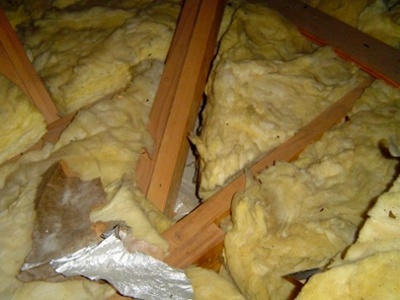
See that photo above? Notice that you don’t see insulation filling all the spaces between the ceiling joists. In this case, it’s because they weren’t cut to fill the cavity completely. Another reason that batts don’t do so well is that the house is full of other stuff where we want the insulation to go: wires, electrical junction boxes, framing, bathroom exhaust fans, can lights… Batts don’t do well when they have to compete against all that.
Blown
A better choice is insulation that comes in smaller chunks. The installer, taking his best firefighter pose, holds a large hose and blows the chunks into the attic. A large machine outside churns the chunks and uses air to blow them up through the hose.
The two main choices here are fiberglass and cellulose, and each has its advantages and disadvantages. They both insulate about the same, though, with R-vales in the 3 to 4 per inch range. Cellulose comes from recycled newspapers. Fiberglass comes from what I’ve heard one major fiberglass insulation manufacturer call a ‘rapidly renewable’ resource – sand. Hmmmm. I don’t know about that, but it’s a common insulation material that works much better in the blown form than in batts.
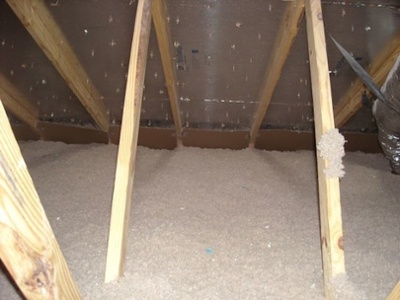
The photo above shows an attic insulated with blown cellulose. Notice how you don’t see any of the ceiling framing down at the ceiling level. You also don’t see any gaps that allow you to see all the way down to the ceiling drywall. That’s because blown insulation is great at filling the gaps and giving you a good, complete layer of insulation.
Sprayed
The third major type of insulation is spray foam. Just as there are two types of blown insulation (fiberglass and cellulose) and two types of people (those who divide everything into two groups and those who don’t), there are two types of spray foam – open cell and closed cell. Each has its pros and cons, as well as its own set of adherents who will tell you never to use the other type. That’s an article for another day, however.
The main advantage of spray foam is that it allows you to move the building envelope – the boundary between conditioned and unconditioned space – from the attic floor to the roofline. If you’ve got your HVAC system and ducts in the stupidest place they could possibly be (the attic), then moving the envelope to the roofline can be a good thing. In a new home, spraying foam in the roofline can bring the ducts inside the envelope without having to redesign the system and house.
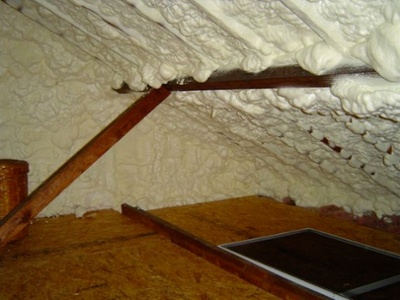
If you don’t have HVAC and ducts in the attic, spray foam on the roofline isn’t really necessary. I’d blow insulation on the attic floor (after air-sealing, of course). The big disadvantage with spray foam is cost. It’s generally 3 to 4 times what you’ll pay for blown cellulose or fiberglass.
Alternative Materials
There are other materials and systems that you can use to insulate your attic. One that I like a lot (since I built a house out of them) is the structural insulated panel. It’s a sandwich of rigid foam insulation and plywood or OSB (oriented strand board, the flaky plywood). One that I don’t like so much, and which you can see below, is the beer can.
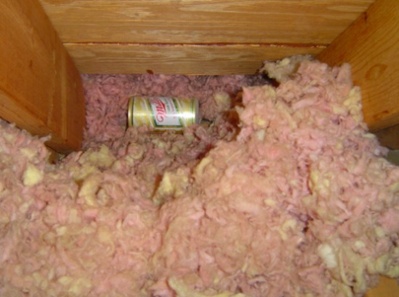
Allison Bailes of Atlanta, Georgia, is a speaker, writer, building science consultant, and the founder of Energy Vanguard. He has a PhD in physics and writes the Energy Vanguard Blog. He is also writing a book on building science. You can follow him on Twitter at @EnergyVanguard.
Related Articles
Is Compressed Fiberglass Insulation Really So Bad?
2 Ways to Get the Best Insulation in Your Home
Does Poor Installation of Insulation Hurt R-Value?
NOTE: Comments are closed.
This Post Has 19 Comments
Comments are closed.

A major downfall of blown is
A major downfall of blown is sometimes it’s “fluffed” (air level set really high on blower machine) to get the correct dept/thickness. Once it settles and is stepped on over the years it looses much of it’s effectiveness.
I agree with you 100%. I do
I agree with you 100%. I do prefer to use blown in cellulose after sealing off top plates and penetrations, etc with spray foam and ensuring that the baffles are installed (correctly). However, I am also a big fan of spray foam and yes, it does cost more. However, if people could spend money on installing two new high efficiency units placed into an unconditioned attic (oven), with leaky duct connections, then they should be able to afford to have spray foam on the underside of the roof, moving the envelope. They will undoubtedly save money every month on energy and their AC units will run more efficiently.
I’m looking forward to meeting you and hearing you speak at the ACI Training Conference in Charlotte. Thank you.
I would add a couple of
I would add a couple of issues to your column that should be performed and install on every single house (and commercial buildings as well):
1. You must do a dew-point analysis to any roof and wall assembly to know what kind and how much insulation you should install on the outside of the sheathing… it’s not a clod climate thing only.
2. Rigid foam, especially to avoid thermal bridging and condensation.
One difference between
One difference between cellulose and fiberglass worth noting is that cellulose is less susceptible to convection currents that can reduce the effective R-value. However, this is mostly a cold-climate issue since convection currents don’t begin to set up until attic drops below freezing. See this report, especially the chart on pg 28 (pdf pg 31): http://1.usa.gov/oa842H
BTW, I don’t like beer cans either, but I do like what’s inside 😉
While it has nothing to do
While it has nothing to do with insulation values or ease of proper insulation, I will just point out that from my job perspective, cleaning up after an attic water pipe leak is far easier if the insulation is in batts than if it was blown in. I have never yet encountered spray foam insulation, but having the insulation above the pipes would make my life even easier, and simultaneously eliminate the most common cause of attic pipe leaks: bursting due to freezing.
On an un-related note, if you have a water heater in your attic, I strongly recommend you find a way to move it to the garage or a closet adjacent to an exterior wall as soon as possible. We have encountered two burst water heaters located in attics since last spring. You don’t want that mess, and if you can’t see your water heater, you’ll have no warning that small leakage is developing into a problem until it’s a big problem.
I’d like to hear the same
I’d like to hear the same information for wall insulation. I have a client whose builder has convinced him that batt insulation that has be “attached” (I assume stapled) is better than blown in insulation because of settling that takes place with blown in. I disagree with this, but would like to send him to written information regarding the differences.
This will be my 20th year in
This will be my 20th year in the cellulose industry and of all the insulation products, it is the only one that is in my 2800′ home. It provides the thermal properties equal and more of the others except close cell polyurethane, it beats all of the others hands down for loss of sound transmission through the walls and in my case floor/ceiling assembly. The underside of my roof and underneath my floor is all cellulose. I have a wife and 3 small children so safety in a fire situation is very much a concern and there are many test that indicate cellulose buys considerably more time to evacuate and fire fighters to respond and that is my main concern. I personally never have thought batts to be an effective way to insulate as compared to spray-on or blown in products for the obvious reason due to poor installation or lack of supervision and/or inspections. This is an opinion only.
Let’s not forget all natural
Let’s not forget all natural wool insulation as well. A great alternative to cellulose.
Another advantage to spray
Another advantage to spray foam insulation, from a pest control perspective, is its resilience to pests especially rats and mice. I’ve seen countless homeowners have to completely clean out and re-insulate their attics after having a rodent problem. Spray foam eliminates this possibility.
Thanks for the article it was
Thanks for the article it was of great help. But I do have a question for anyone out there. I bought a older home 20 years ago and it always seem cold so I had somone gut it and add 3 1/2″ of faced insolation in the walls and covered it with 1/2″ drywall it did not help I then had the siding removed and installed 1/2″ foil face sheating and new siding again did not help I then chaulked all around the bottom of the foil sheating on the outside of the house and all around the bottom of the drywall on the inside again did not help last year I installed new windows triple pane with storms on the outside this help some but still could feel a breeze
just last week I had a new top of the line furnace installed along with a complete duct work make over and it is now much better but can still feel that breeze. I have sealed the tops of the basement walls and insolated the sill boxes and the breeze continues my next thought is to add 10″ of insolation to my one attic it is batts now but only 5 1/2″ my other attic has about 12″ of cellulose with some areas only about 4″ thick due I think to some electrical work that was done in there I am was told to blow in another 12″ to get an R value of about 49 Does this soulnd like a good idea? I am also wondering if I should somehow seal the outside wall areas between the studs in the attic although I have not yet looked I got a feeling that the batts in the walls maybe puckered the areas for cold area to come down the walls from the attic does seam like a good idea or is there a better option? With spending $25000.00 dollars in the last 2 yrs. to fix this problem all I seem to be gaining is getting new and update top of the line products. I have had a number of people out to look at the problem but had any answers. My attics by the have both gable vents and roof vents. Any suggestion are greatly appreciated.
Wow I see I could use a
Wow I see I could use a typing lesson with any money I may save from the above. Hopefully every one can read over my typos.
Paul wrote:
Paul wrote:
> I have had a number of people out to look at the problem…
Were any of these trained auditors who weren’t there primarily to sell products? In particular, did you pay for an comprehensive energy audit? Without prejudice, a free audit is worth every penny you pay for it.
A skilled auditor with blower door, IR camera and a few other tools could have tested and diagnosed your home in order to reveal the issues with your envelope, in particular, the precise source of the ‘breeze’ you’re experiencing. Then, software modeling can help you focus resources on improvements that will provide the best value.
Given the amount you’ve already spent, you would do well to spend a few hundred dollars to have an auditor identify the source of the drafts you’re feeling, using a blower door and IR camera.
BTW, you didn’t mention your location, but adding more inches of cellulose to the attic that already has 12 inches isn’t going to help much. But you do need to need to fill in the low spots.
I don’t understand your last question, but if you have knee-walls exposed to a vented attic, those definitely need to be air sealed, and fully encapsulated (e.g, six-sided enclosure of each stud bay). Insulation in a knee-wall that’s exposed on the back (or top, or bottom) won’t work very well.
hmm
hmm
Great post. Keep in mind that
Great post. Keep in mind that when you do decide to add additional insulation, each area has a specific recommended depth. A great place to find additional information is http://www.energystar.gov/index.cfm?c=home_sealing.hm_improvement_insulation_table
Hey guys, I have a question.
Hey guys, I have a question. I just had an energy audit from a company that our state and utilities contract with. The conclusions in the audit recommended that they blow in cellulose and do air sealing of all the top plates to bring our R value from 18 up to 49. They also will barricade our attic pulldown and add a battic door. The total for the job is about $2,700, $2,500 of which can be financed for 3 years at 0% through the state. It is estimated this work will save us over $700/year in heating and cooling costs based on our usage history. Any thoughts?
@Tony, I have no idea where
@Tony, I have no idea where you live or how much your heating and cooling bills have been running, but $700/yr savings sounds a bit high.
Strictly from an R-value standpoint, increasing R18 to R49 will reduce ceiling conducted load about 60%. Let’s say you spend $2500/yr for heat/cool and the ceiling represents 20% of that, then you’d expect to see a savings of $300. If infiltration represents 30% of your load and sealing your top plates reduces that by 20%, then you’d expect to save another $150. These are just guesstimates but it gives you an idea of how to scope the savings.
If the auditor didn’t model your home and true up the model to historical energy bills, then I wouldn’t put much credence in his savings estimate.
That said, I do recommend having the work done, but be sure to get another quote to make sure you’re not overpaying.
Considering blown-in
Considering blown-in cellulose or spray foam. Besides cost…what are the health implications of both (I have 2 toddlers at home, both with bedrooms directly under attic)… Cellulose deterioration over time and/or chemicals in air from that an issue? Spray foam chemicals an issue besides the 1-2 days after install (dissipates quickly & almost entirely?)? I also hear cellulose is not fun to get through when replacing air handlers in attic or trying to navigate the attic in general?
Blown in cellulose or blown
Blown in cellulose or blown in fiberglass? Which makes the most mess to clean up, either during installation or afterwards? Husband, toddler granddaughter and I all have allergies so we are concerned about residual dust/allergens.
Hi Jo
Hi Jo
Here in S Florida I’m wrestling with the same issue, having to replace existing blown in fiberglass due to past rodent infestation. Spray is not such a great idea altho it was my choice in the past ‘up North’ due to possibility of termites getting in under. Also possible slight offgassing chances.
Cellulose I know is very dusty but its pretty inert and if the main fire retardant is borax, that is not a health danger. Fiberglass looks easier to deal with BUT what are the long term effects of all those tiny fibers ? Wish blown in rockwool was available.